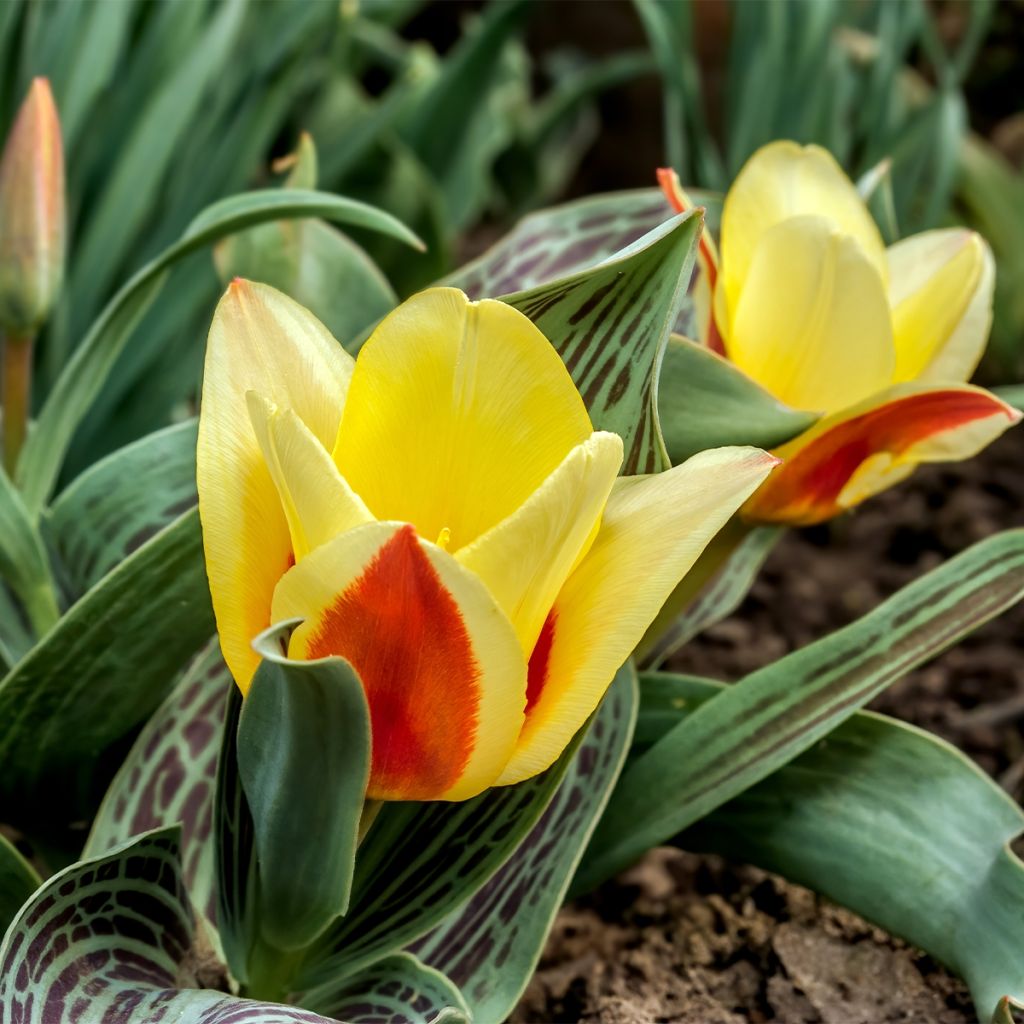

Tulipe naine greigii Mélodie d'amour
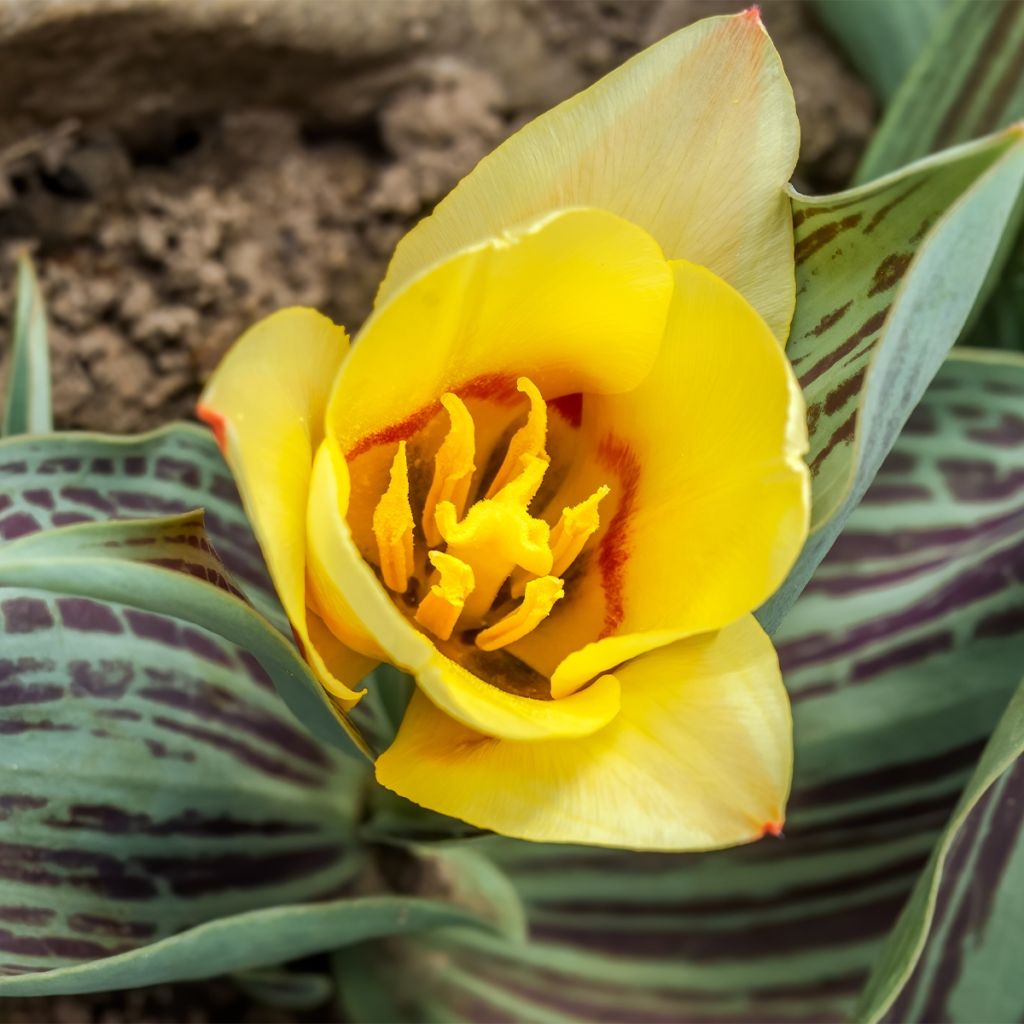

Tulipe naine greigii Mélodie d'amour
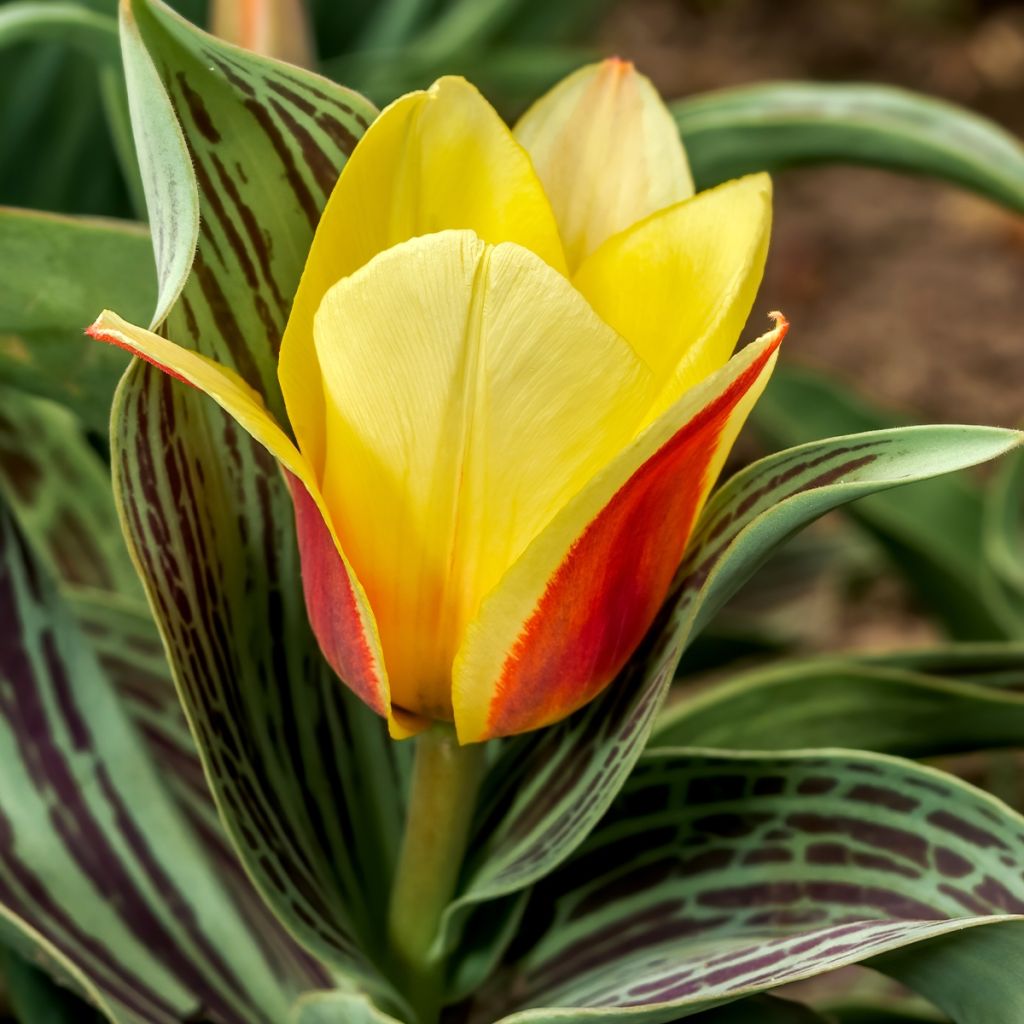

Tulipe naine greigii Mélodie d'amour
Tulipa greigii 'Melody d'Amour'
Tulipa greigii Mélodie d'amour
This plant carries a 6 months recovery warranty
More information
We guarantee the quality of our plants for a full growing cycle, and will replace at our expense any plant that fails to recover under normal climatic and planting conditions.
From €5.90 for pickup delivery and €6.90 for home delivery
Express home delivery from €8.90.
Does this plant fit my garden?
Set up your Plantfit profile →
Description
The botanical Tulipa greigii 'Melody d'Amour', is a dwarf variety with flamboyant flowers that doesn't go unnoticed in the garden. Its corollas of bright red, edged with vibrant yellow, open up in large stars under the sun. They bloom on ample foliage marbled with purple, which is not without appeal. Botanical tulips can remain in the ground and will flower for many years. Bulbs should be planted in autumn for an early April flowering.
The Botanical Tulipa greigii 'Melody d'Amour', registered in 1975, belongs to the Liliaceae family. The species Tulipa greigii was the first to be cultivated from wild bulbs, which were brought from Uzbekistan to Germany in 1871. It is actually native to Central Asia and northeastern Iran. It has given rise to numerous cultivars. This small 'Melody d'Amour' tulip will not exceed 15-20cm (6-8in) in height when in bloom. Its foliage is bluish green, quite wide, marked with darker marblings. The flowers appear in March-April, earlier or later depending on the climate. They bloom under the sun and close up when it hides. The foliage dries up a few weeks after flowering, marking the bulb's entry into dormancy.
Botanical tulips do not degenerate over time like large-flowered tulips, which have been selected for over 200 years for cut flowers and not for their longevity. They naturalize easily and can remain in place for several years without special maintenance. They thrive in borders and rockeries, in very well-drained soil. To create colourful scenes, they can be combined with various small bulb plants: Crocus, Allium, Ipheion uniflorum, Anemone blanda, small-flowered Narcissus, Muscari, Cyclamen coum, snowdrops, Scilla sibirica... These tulips are unrivaled for bringing the colours of spring to pots or sunny gardens.
Report an error about the product description
Tulipa greigii 'Melody d'Amour' in pictures
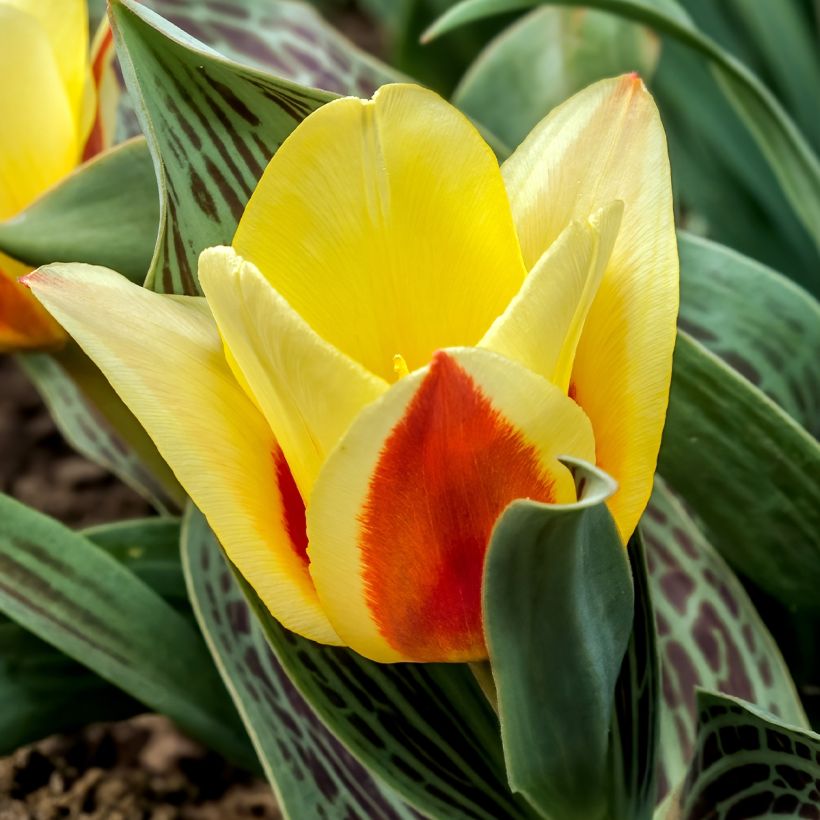

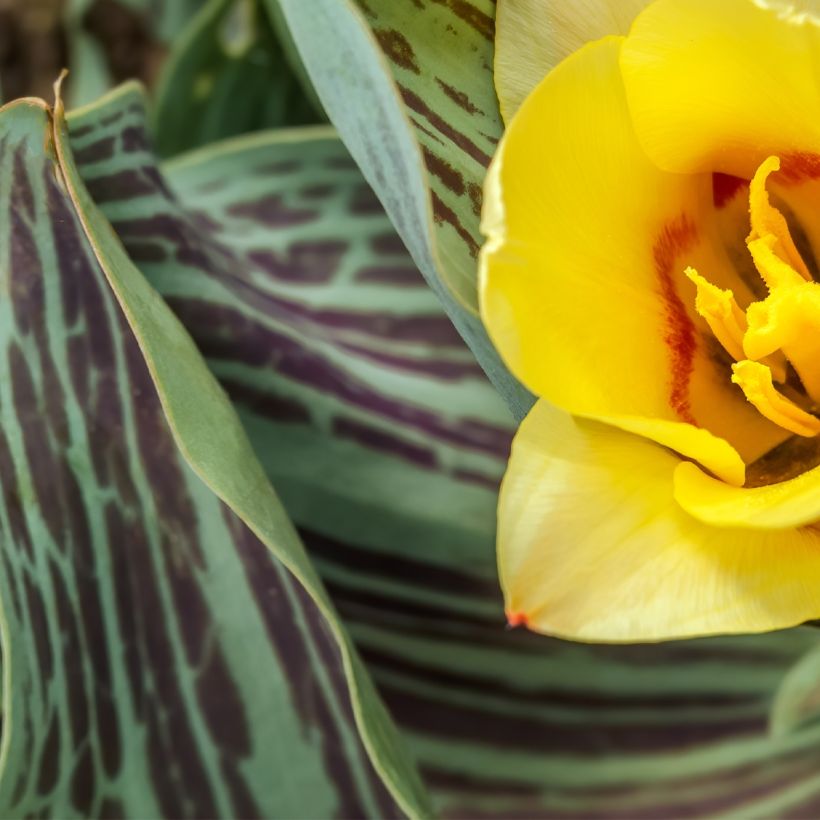

Plant habit
Flowering
Foliage
Botanical data
Tulipa
greigii
Mélodie d'amour
Liliaceae
Cultivar or hybrid
Planting and care
Tulip bulbs should be planted from October to mid-December for spring flowering. Plant them in full sun or possibly in partial shade. Tulips appreciate rich, well-drained soil and can tolerate dry soil in summer. If your soil is very clayey, incorporate some sand into the soil before planting or add a few gravels at the bottom of the planting hole. Botanical tulips are hardy and also thrive in poor soils or rock gardens.
Work the soil deeply and remove unwanted weeds or rocks. Dig a hole using a bulb planter and bury the bulbs, pointy end up, two to three times their height. Space the bulbs about 10cm (4in) apart. Bulbs can be planted individually or in groups of 5 to 10 for a beautiful colour effect. You can place them one by one on the ground or "scatter" them on the ground for a more natural effect in flower beds. Lightly water after planting.
For container planting, provide drainage at the bottom of the pot (clay pellets or gravel) and then plant the bulbs in a mixture of potting soil, garden soil, and a little sand. Add a small amount of compost when flowering.
Tulips require little maintenance. Water in spring if necessary. Remove faded flowers to avoid exhausting the bulb. After flowering, allow the foliage to die naturally and only cut it when it turns yellow to promote the accumulation of new reserves in the bulb.
Botanical tulips can remain in place for several years. The production of bulblets allows them to spread and naturalize, making them perennial. If the clumps become less floriferous, gently dig up the bulbs once the foliage has withered and divide the bulbs to replant them elsewhere in the garden.
Planting period
Intended location
Care
-
, onOrder confirmed
Reply from on Promesse de fleurs
Haven't found what you were looking for?
Hardiness is the lowest winter temperature a plant can endure without suffering serious damage or even dying. However, hardiness is affected by location (a sheltered area, such as a patio), protection (winter cover) and soil type (hardiness is improved by well-drained soil).

Photo Sharing Terms & Conditions
In order to encourage gardeners to interact and share their experiences, Promesse de fleurs offers various media enabling content to be uploaded onto its Site - in particular via the ‘Photo sharing’ module.
The User agrees to refrain from:
- Posting any content that is illegal, prejudicial, insulting, racist, inciteful to hatred, revisionist, contrary to public decency, that infringes on privacy or on the privacy rights of third parties, in particular the publicity rights of persons and goods, intellectual property rights, or the right to privacy.
- Submitting content on behalf of a third party;
- Impersonate the identity of a third party and/or publish any personal information about a third party;
In general, the User undertakes to refrain from any unethical behaviour.
All Content (in particular text, comments, files, images, photos, videos, creative works, etc.), which may be subject to property or intellectual property rights, image or other private rights, shall remain the property of the User, subject to the limited rights granted by the terms of the licence granted by Promesse de fleurs as stated below. Users are at liberty to publish or not to publish such Content on the Site, notably via the ‘Photo Sharing’ facility, and accept that this Content shall be made public and freely accessible, notably on the Internet.
Users further acknowledge, undertake to have ,and guarantee that they hold all necessary rights and permissions to publish such material on the Site, in particular with regard to the legislation in force pertaining to any privacy, property, intellectual property, image, or contractual rights, or rights of any other nature. By publishing such Content on the Site, Users acknowledge accepting full liability as publishers of the Content within the meaning of the law, and grant Promesse de fleurs, free of charge, an inclusive, worldwide licence for the said Content for the entire duration of its publication, including all reproduction, representation, up/downloading, displaying, performing, transmission, and storage rights.
Users also grant permission for their name to be linked to the Content and accept that this link may not always be made available.
By engaging in posting material, Users consent to their Content becoming automatically accessible on the Internet, in particular on other sites and/or blogs and/or web pages of the Promesse de fleurs site, including in particular social pages and the Promesse de fleurs catalogue.
Users may secure the removal of entrusted content free of charge by issuing a simple request via our contact form.
The flowering period indicated on our website applies to countries and regions located in USDA zone 8 (France, the United Kingdom, Ireland, the Netherlands, etc.)
It will vary according to where you live:
- In zones 9 to 10 (Italy, Spain, Greece, etc.), flowering will occur about 2 to 4 weeks earlier.
- In zones 6 to 7 (Germany, Poland, Slovenia, and lower mountainous regions), flowering will be delayed by 2 to 3 weeks.
- In zone 5 (Central Europe, Scandinavia), blooming will be delayed by 3 to 5 weeks.
In temperate climates, pruning of spring-flowering shrubs (forsythia, spireas, etc.) should be done just after flowering.
Pruning of summer-flowering shrubs (Indian Lilac, Perovskia, etc.) can be done in winter or spring.
In cold regions as well as with frost-sensitive plants, avoid pruning too early when severe frosts may still occur.
The planting period indicated on our website applies to countries and regions located in USDA zone 8 (France, United Kingdom, Ireland, Netherlands).
It will vary according to where you live:
- In Mediterranean zones (Marseille, Madrid, Milan, etc.), autumn and winter are the best planting periods.
- In continental zones (Strasbourg, Munich, Vienna, etc.), delay planting by 2 to 3 weeks in spring and bring it forward by 2 to 4 weeks in autumn.
- In mountainous regions (the Alps, Pyrenees, Carpathians, etc.), it is best to plant in late spring (May-June) or late summer (August-September).
The harvesting period indicated on our website applies to countries and regions in USDA zone 8 (France, England, Ireland, the Netherlands).
In colder areas (Scandinavia, Poland, Austria...) fruit and vegetable harvests are likely to be delayed by 3-4 weeks.
In warmer areas (Italy, Spain, Greece, etc.), harvesting will probably take place earlier, depending on weather conditions.
The sowing periods indicated on our website apply to countries and regions within USDA Zone 8 (France, UK, Ireland, Netherlands).
In colder areas (Scandinavia, Poland, Austria...), delay any outdoor sowing by 3-4 weeks, or sow under glass.
In warmer climes (Italy, Spain, Greece, etc.), bring outdoor sowing forward by a few weeks.



































